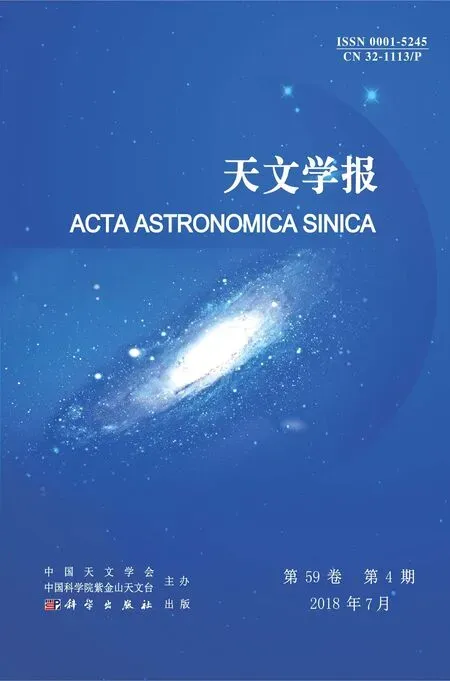触发式恒星形成特征的搜寻和1.3 cm波段的谱线巡测
龚 龑
(中国科学院紫金山天文台南京210008)
本论文分为两个部分.第1部分基于紫金山天文台13.7 m毫米波望远镜的分子谱线巡天项目—“银河画卷”计划,对一个红外尘泡的样本和一个大天区的12CO/13CO/C18O(J=1−0)成图观测,搜寻触发式恒星形成的运动学特征,并结合红外卫星和射电连续谱档案数据,研究相应的分子团块、年轻恒星分布及恒星形成规律等.第2部分是利用E ff elsberg-100 m望远镜对IRC+10216和Orion KL进行了1.3 cm波段的谱线巡测.
我们通过对选定有大质量恒星形成迹象的17个天区做CO同位素分子谱线的成图观测,研究其中30个红外尘泡样本的分子气体性质.包裹着红外尘泡的分子壳层按形态和可能的演化序列分为:完整型-破损型-不规则型.与尘泡成协电离氢区的动力学年龄分析支持我们提出的演化序列图像.在其中17个尘泡周围分子壳层的速度-位置图中发现圆形或弓形的膨胀运动学特征,相应的膨胀速度为2.5–7.5 km·s−1,这种超声速的膨胀很可能是由于电离氢区和周围分子云相互作用导致的.我们从这17个天区内证认了379个13CO分子团块和245个C18O分子团块,并给出了局部热动平衡假设下的物理参数.分析表明,其中有16个尘泡周围都存在成协的大质量恒星形成团块,它们是深入研究“收集和塌缩”模型的理想候选样本.
我们对银道面(216.25◦6 l 6218.75◦和−0.75◦6 b 61.25◦)范围内共约3.75deg2天区进行3条CO同位素分子谱线的巡天观测,该区域在视线方向上有3个速度成分:15 km·s−1、27 km·s−1和50 km·s−1,其中27 km·s−1云主要包括一个处于超临界状态的纤维状结构S287-main. 巡天工作首次发表的C18O(J=1−0)成图数据在S287-main中发现7个大质量C18O团块,分布在分子气体最大柱密度线上.对这些团块的质量-尺度关系研究表明:它们均有可能形成大质量恒星.对50 km·s−1成分获得首次可分辨分子谱线成图观测,揭示出其中3个正在膨胀的较大尺度的分子气体壳层结构.区域中年轻星分布在电离氢区S287附近和50 km·s−1成分云中的壳层结构交界处呈现富集,表明这些年轻星的形成很有可能是电离氢区和壳层结构的膨胀所触发的.分子云中无处不在的纤维状结构的碎裂过程是恒星及星团形成的关键环节.与碎裂理论模型的比较表明,S287-main中大尺度的碎裂是湍动主导的,而在形成年轻星的尺度上,引力主导的碎裂起重要作用.对处于外银河环境下分子云的恒星形成关系的研究发现,它们与在较低质量近邻分子云的研究结果一致,即:恒星形成率面密度明显高于从河外星系的Schmidt-Kennicutt关系所预期的值.
我们在IRC+10216和Orion KL的1.3 cm谱线巡测中探测并证认出的所有分子谱线均来自这两个源中已知的星际分子.在IRC+10216中发现了78条分子谱线,其中有12条是没有证认出来的“U”线,谱线密度为每GHz约9条.证认出的谱线来自18种不同的星际分子.其中23条谱线是第一次在星际介质中探测到,还有另外20条谱线是第一次在IRC+10216星周包层中探测到.对NH3的非局部热动平衡分析表明:大部分的NH3发射是来源于动能温度至少为(70±20)K的内部包层.我们通过研究HC5N的不同13C同位素分子发现它们的丰度可能不同,并得到同位素丰度比12C/13C=49±9.与暗云TMC-1的对比分析发现,IRC+10216星周包层中更容易形成含硅的分子.在Orion KL中,我们发现并证认261条谱线,包括164条氢、氦、碳的射电复合线和13种分子的97条谱线.对应的谱线密度为每GHz约32条,其中有23条分子谱线是第一次在星际介质中探测到.15NH3非亚稳态(J>K)系列跃迁在Orion KL中是第一次被探测到.结合阿塔卡玛毫米/亚毫米波阵列望远镜(ALMA)对Orion KL中11种分子的档案资料,我们讨论了这些分子跃迁的发射区域.我们还发现SO2(81,7-72,6)中一个可能的脉泽发射成分.我们给出了局部热动平衡假设下12个分子的柱密度和它们相对于H2的丰度.转动图方法分析表明14NH3非亚稳态跃迁中,从J=K+1到J=K+4的跃迁可能示踪不同的发射区域;15NH3亚稳态(J=K)跃迁和非亚稳态跃迁也可能示踪着不同的区域.我们还通过谱线对的强度比估计了元素丰度比和同位素丰度比:He/H=(8.7±0.7)%、12C/13C=63±17、14N/15N=100±51、D/H=(8.3±4.5)×10−3.
This thesis consists of two parts.The first part,based on the Milky Way Imaging Scroll Painting(MWISP)project,observationally studies a sample of infrared bubbles and a region of 3.75 square degrees in three main CO isotopic lines.It focuses on searching for the signs of triggered star formation,and studying the physical properties of molecular shells and associated clumps,the distribution of young stellar objects,and corresponding star formation laws.The second part is concentrated on a 1.3 cm spectral line survey toward IRC+10216 and Orion KL.
We carried out simultaneous observations of12CO(1-0),13CO(1-0),and C18O(1-0)with the PMO(Purple Mountain Observatory)13.7 m telescope toward 30 infrared bubbles in 17 regions which show massive star formation signposts.On the basis of the morphologies of molecular clouds around these bubbles,we divide resolved targets into three morphological types,“complete”,“broken”,and “irregular”.We propose an evolutionary trend in which the “complete”-“broken” sequence is supported by the dynamic ages of associated H II regions.Toward 17 out of 30 bubbles,we find that their associated molecular shells display circular-or arc-like features in position-velocity diagrams,and indicative of expansion.Their expansion velocities are 2.5–7.5 km·s−1,suggesting that the expansion is supersonic.This is likely due to interactions between H II regions and ambient molecular clouds.The physical properties of the 17 molecular shells are also derived by assuming local thermodynamic equilibrium(LTE).In the associated molecular clouds,we identify 37913CO clumps and 245 C18O clumps,and their physical properties are also derived under the LTE assumption.An analysis suggests that there are massive star-forming molecular clumps around 16 bubbles.A statistical analysis con firms the presence of an over-density of clumps in the periphery of bubbles.We also find that bubble-associated clumps tend to have higher excitation temperatures than unassociated clumps.The clump mass functions(CMFs)of bubbleassociated and unassociated clumps are nearly the same,suggesting that the CMF is littlea ff ected by the feedback of bubbles.
We study the physical properties of molecular clouds and their associated star formation toward the Galactic plane within 216.25◦6 l 6218.75◦and −0.75◦6 b 61.25◦,which covers the molecular cloud complex S287.We reveal three molecular clouds,the 15 km·s−1cloud,the 27 km·s−1cloud,and the 50 km·s−1cloud,in the surveyed region.Investigating their morphology and velocity structures,we find that the 27 km·s−1cloud is likely a ff ected by feedback from the stellar association Mon OB3,and the 50 km·s−1cloud is characterized by three large expanding molecular shells.We discover seven C18O clumps and 15 dust clumps that are likely to form massive stars.Using infrared color-color diagrams,we find 56 Class I and 107 Class II young stellar object(YSO)candidates toward a slightly larger region of 5.0 square degrees.An over-density of YSO candidates is found around the H II region S287 and the intersection of two shells,indicative of triggering.Comparing the observed values of the filament S287-main with fragmentation models,we suggest that turbulence controls the large-scale fragmentation in the filament,while gravitational fragmentation plays an important role in the formation of YSOs on small scales.Using the 1.1 mm dust emission to trace dense gas,we obtain a dense gas fraction of 2.7%–10.4%for the 27 km·s−1cloud.
We carried out a spectral line survey with the Effelsberg-100 m telescope toward IRC+10216 and Orion KL at λ∼1.3 cm.In the circumstellar shell of IRC+10216,we find 78 spectral lines,among which 12 remain unidentified.The identified lines are assigned to 18 different molecules and radicals.A total of 23 lines from species known to exist in this envelope are detected for the first time outside the solar system and there are additional 20 lines first detected in IRC+10216.Assuming LTE,we then determine rotational temperatures,column densities,and abundances of 17 detected molecules.A non-LTE analysis of NH3shows that the bulk of its emission arises from the inner envelope with a kinetic temperature of(70±20)K.Potential abundance differences between various13C-bearing isotopologues of HC5N are evaluated.Overall,the isotopic12C/13C ratio is estimated to be 49±9.Finally,a comparison of detected molecules in the λ∼1.3 cm range with the dark cloud TMC-1 indicates that silicate-bearing molecules are more predominant in IRC+10216.In Orion KL,we find 261 spectral lines.The identified lines include 164 radio recombination lines(RRLs)and 97 molecular lines.The molecular lines are assigned to 13 different molecular species including rare isotopologues.A total of 23 molecular transitions from species known to exist in Orion KL are detected for the first time in the interstellar medium.Non-metastable(J>K)15NH3transitions are detected in Orion KL for the first time.Based on the velocity information of detected lines and the ALMA images,the spatial origins of molecular emission are constrained and discussed.A narrow feature is found in SO2(81,7-72,6),possibly suggesting the presence of a maser line.Column densities and fractional abundances relative to H2are estimated for 12 molecules with LTE methods.Metastable(J=K)15NH3is found to have a higher excitation temperature than non-metastable15NH3,also indicating that they may trace different regions.Elemental and isotopic abundance ratios are also estimated:He/H=(8.7±0.7)%derived from the ratios between helium RRLs and hydrogen RRLs;12C/13C=63±17 from12CH3OH/13CH3OH;14N/15N=100±51 from14NH3/15NH3;and D/H=(8.3±4.5)×10−3from NH2D/NH3.

